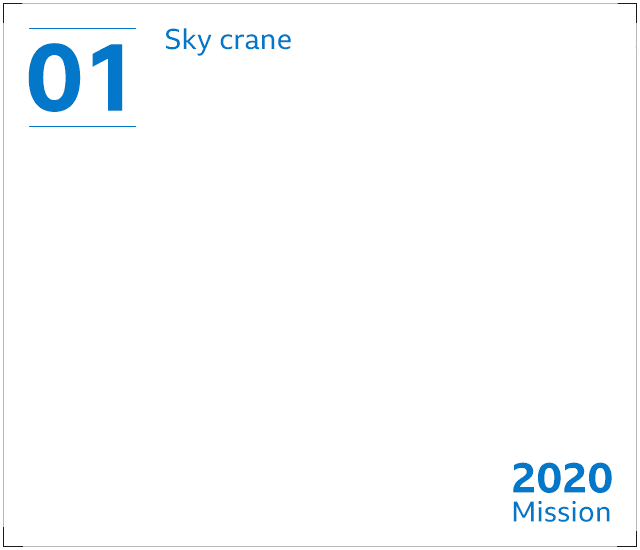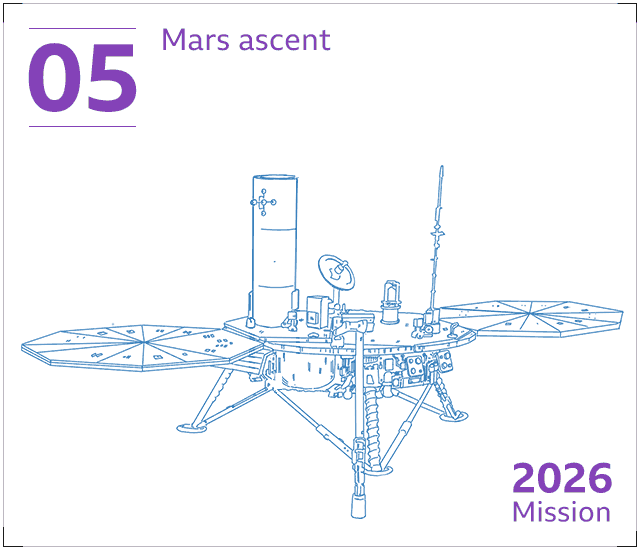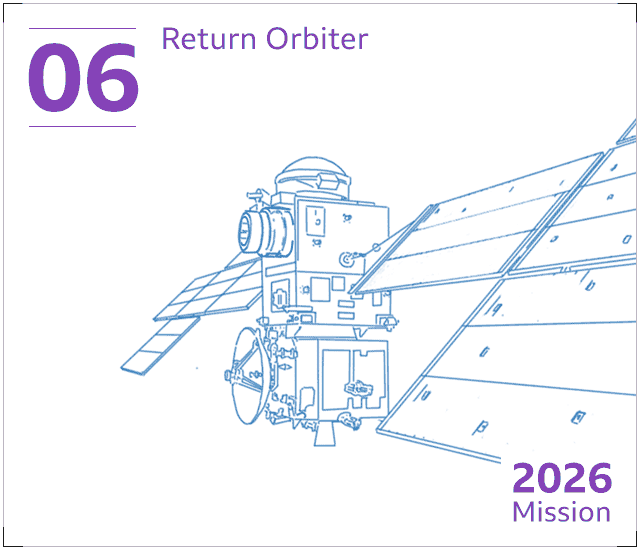Election 2017: How election results are calculated and reported by the BBC
- Published
Key questions about general election results, and how the BBC reports them, are answered below.
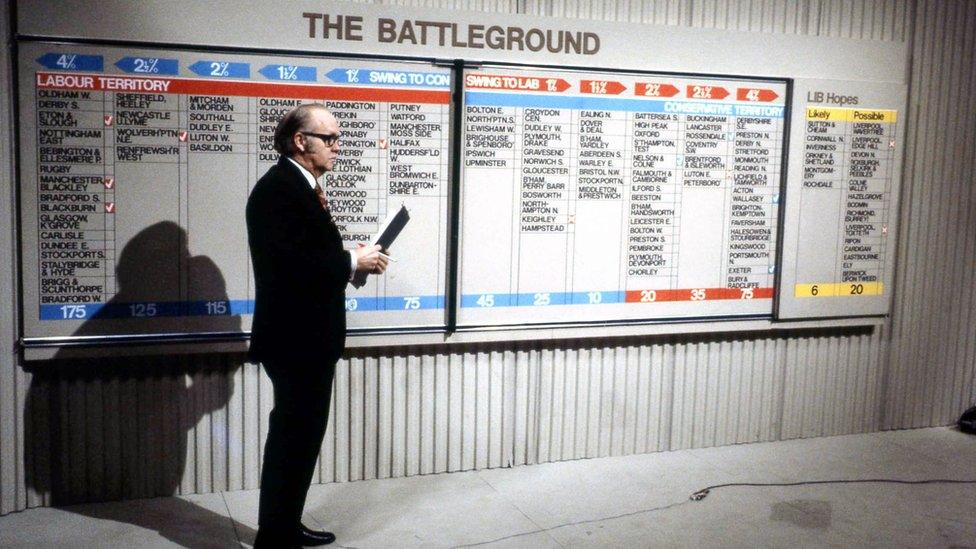
How does a party win?
By winning more seats in the House of Commons than all the other parties put together. If a party does that, it has what is known as a majority. There are 650 seats available, which means 326 seats are needed to win an overall majority.
However, an effective majority could be smaller as the Speaker and his deputies, although MPs, do not usually vote. Also, Sinn Fein, which won four seats in Northern Ireland in 2015, traditionally refuses to swear allegiance to the Queen, and is not entitled to vote as a consequence.
What is a constituency?
Also called a seat, in a general election, this is where the political battles are fought. Voters in each constituency choose just one MP.
Have constituencies changed since the last general election in 2015?
No.
But a reduction in the number of MPs from 650 to 600 and changes to some constituency boundaries was proposed in September 2016 and is now under public consultation. Final proposals are expected to be made in 2018.
What happens in the Speaker's seat?
The Speaker of the House of Commons is an MP and has to stand for re-election as Speaker in his, or her, constituency at every general election.
Traditionally the biggest parties in the House of Commons do not stand against the Speaker however some parties, such as UKIP and the Green Party do.
The current Speaker, John Bercow, is standing for election in Buckingham.
The Speaker is a neutral figure in Parliament, so Mr Bercow is no longer a member of the Conservative Party as he was before his election to the role (by parliament).
However, for the purposes of calculating the number of seats belonging to each party - and calculating those held, gained or lost by each party - Mr Bercow's seat is regarded as being a Conservative constituency, as he won it for the party in 1997, 2001 and 2005 before being elected speaker.
If Mr Bercow wins again, the result in Buckingham will be described as "Speaker hold" - and his seat will be added to the Conservative total.
The BBC follows the same principle at every general election.
What is meant when a party wins, holds or gains a seat?
What matters most is how many "seats" each party wins, and for things to change political parties need to win seats from each other.
Because winning seats from each other is so important, a special language is used to show this. Seats that are won can mainly fall into two categories: hold or gain.
Hold: If a party wins a seat that it won in 2015, this is described as a "hold"
Gain: If a party wins a seat that it did not win in 2015, this is called a "gain"
Win: Where there has been a by-election since the 2015 election and that by-election resulted in a different party gaining the seat compared with the general election result
Clearly these are really important to the opposition parties.
If they are to form a new government, they need to win seats from the existing government and other parties to make "gains", while they retain or "hold" all the seats they had last time.
What about by-elections?
By-elections are one-off elections in seats where, for example, the sitting MP has stood down or died. There have been 10 by-elections since 2015.
When the BBC reports general election results, all of these interim by-elections are ignored, to allow for straightforward comparison with 2015's seats.
The BBC uses slightly different terminology to describe results where seats have changed hands in by-elections.
For example: in 2016 Liberal Democrat Sarah Olney won Richmond Park from Conservative Zac Goldsmith.
If Zac Goldsmith regains the seat on 8 June, the result will be described as a "Conservative Win". It will not appear as a net gain in the Conservatives' overall UK seat tally.
However, if an entirely different party wins a by-election seat, that result will be described as a "gain" from whichever party won the seat in 2015.
The BBC adopts this policy in recognition of the very particular circumstances which often shape the outcome of by-elections.
Comparing seat change from 2015 represents a fairer way of representing how the political expression of voters has altered from general election to general election.
What is a majority?
To win an election, a party must win enough seats in the House of Commons to form a government. To do that simply one party needs to get one more seat than all the others added together.
That is called an overall majority, but in the shorthand language of elections it is just called a majority.
There are 650 seats in Parliament, so to get one more than everyone else put together a party must get 326 or more to get a "majority".
Of course it makes things much easier for a government if they have many more MPs than all the others put together.
That number is called the size of the majority. So, if one party were to win 326 seats, then all the other parties added together would be 324.
The majority is therefore 326 minus 324: two. So the smallest majority possible is not one seat but two.
Another quick way of working this out is to take away 325 from the number of seats that the winning party has got and double the result. For example:
If the winning party has 350 seats what is the majority?
350-325=25
25x2=50
So the majority is 50.
A tip for any office sweepstake on the size of the majority is never bet on an odd number.
What is a hung parliament?
A hung parliament happens when no single party wins a majority.
A party can stay in power without an absolute majority by trying to forge an alliance with a smaller party to create a coalition government.
Alternatively, it can aim to reach agreements with smaller parties to support it in parliament in the event of a confidence motion aimed at bringing down the government.
Another possibility is for the biggest party to form a minority government with no agreements with other parties, and just try to form majorities in favour of each individual bill as it comes up - an arrangement sometimes called confidence and supply.
If no party is prepared to go down one of these paths then parliament will be dissolved again and there will be another election.
The general election in 2010 ended in a hung parliament, with the Conservatives the largest party. After negotiation, a coalition government was formed between the Conservatives and the Liberal Democrats.
What is an exit poll and seat prediction?
An exit poll is conducted by approaching voters as they leave polling stations and asking them to fill in a mock ballot paper to indicate how they have just voted.
The exit poll is carried out by polling companies GfK and Ipsos Mori for the BBC, ITV News and Sky News.
The results of the exit poll will allow BBC analysts to forecast approximately how many seats each party has won.
Results on the BBC website
Which parties appear in the summary results graphic at the top of the BBC News website?
When polls close at 22:00 BST, the BBC will broadcast the results of the exit poll. The projected seats for the top five parties based on the exit poll will be displayed in the summary graphic as grey bars.
When the first results are declared, around an hour later, parties will begin to be ordered left to right by number of seats won at that time.
As the night progresses, the summary results graphic will always display the top five parties according to seats won. All other parties' seats will be amalgamated into "Others".

The BBC's 2015 results summary graphic
Full results are always available via the link to the results homepage, which contains a listings and breakdown of seats, votes and vote share by party.
When all results are known, the summary graphic will conclude by displaying the top five parties by seats won in the new Parliament.
In the event of a tie in the top five - eg two parties have two seats - the party with the most votes will be named.
There are no seat predictions available for parties in Northern Ireland, as the exit poll is carried out in Great Britain (GB) only.
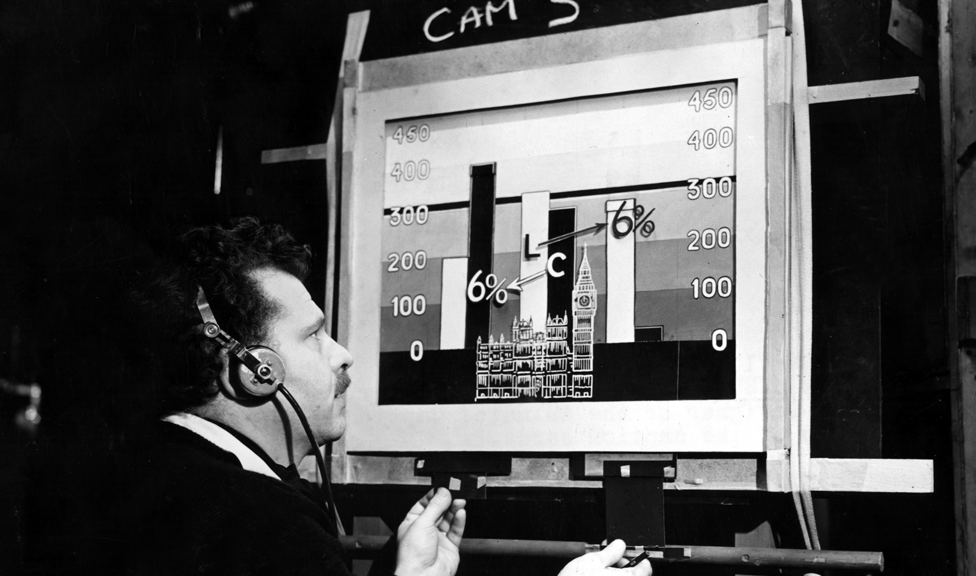
The technology has changed, but the principles remain
Which parties are listed in the overall results tables?
To appear as a named party in either the overall UK scoreboard or a nation scoreboard, a party must fulfil one of the following criteria:
Standing in one-sixth of seats in any UK nation
Fielding more than five candidates either across the UK or in a single nation
Achieved greater than 1% of the vote at UK or nation level at the last general election
Had a sitting MP in the last parliament
All parties which do not meet these criteria are amalgamated into a group called Others.
An aggregated tally of votes for the 191 independent candidates is also shown on the main UK scoreboard.
Each constituency page will always name every party and independent standing in that constituency.
The BBC only recognises parties which are registered as political parties by the Electoral Commission.
How does the BBC calculate turnout?
On election night, the BBC calculates percentage turnout by dividing the number of valid votes cast for all candidates by the number of people eligible to vote (known as the electorate)
Spoilt or rejected ballots are not included.
The UK and nations turnout figures update through the night, based on electorates divided by valid votes of all constituencies declared so far.
Why does the postcode search not give the result I expect?
Sorry, your browser cannot display this content.
The postcode search box uses the latest available data supplied by Ordnance Survey.
Discrepancies can occasionally occur when a postcode search returns a different constituency to the one given on polling cards sent to an address at the same postcode.
Normally the constituencies concerned are next to each other, and it appears these discrepancies occur when postcodes are on the border between the two constituencies.
We would advise people affected to follow the information on their polling card in terms of the constituency they are in and the polling place to be used on 8 June.
